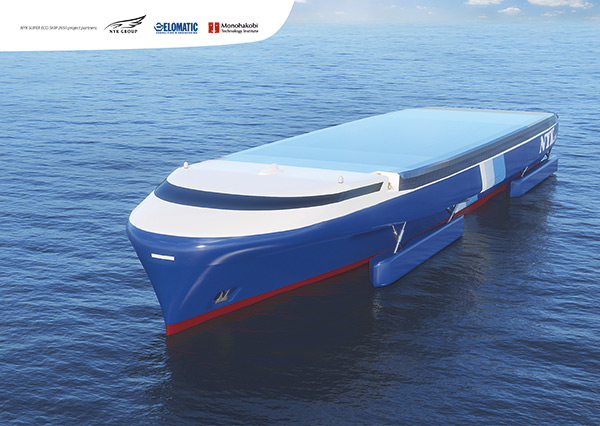Consulting
Equipment
Materials
Safety
Systems
An emission-free cargo ship has already been designed

Consulting group Elomatic has developed a concept design for the NYK Super Eco Ship 2050. The aim was to create a concept for an emission-free car and truck carrier concept, in cooperation with NYK of Japan. The concept ship incorporates various futuristic but feasible modern technologies.
Mr. Tomas Aminoff – Senior Consultant for Marine Technology for Elomatic Group in Espoo, Finland – recounts that the Japanese NYK Group contacted Elomatic for cooperation in a design consept for an emission-free cargo carrier, ready to comply with next-generation environmental regulations.
”The project was started before IMO published their latest emission regulations for ships. NYK Group wanted to be prepared for even stricter rules and regulations,” Mr. Aminoff says.
”Consequently, Elomatic reviewed the new marine technologies that are in the process of being developed, with a view to determining how they might be utilised for minimising environmental emissions of ships.”
Ships that resemble this concept for a futuristic car and truck carrier – at least remotely – may be in commercial use in or around 2050.
Energy demand minimised
According to Mr. Aminoff, the essential thing was to utilise fuels that would reduce CO2 emissions by 100 percent. Instead of fossil fuels, the ship might be powered by hydrogen produced from renewable energy sources.
”New types of fuels will probably be inconvenient to store – and are liable to take up a lot of storage space onboard – so the new ship needs to be highly energyefficient,” he points out.
The energy demand of the vessel was cut by approximately 70 percent by eliminating energy and operational waste. Small amounts of waste may be stored on board for later in-port disposal. The minimised energy demand enables emissionfree operation. Surplus cooling energy can be utilised in air-conditioning.
What’s more, the upper side of the ship will be covered by 9,000 square metres of solar panels, providing 15 percent of the ship’s energy demand.
”In modern hull design, ensuring ship stability is usually an issue. For our design concept, we assume that stability can be maintained by utilising active pontoons on each side and gyro stabilisers, rather than resorting to using ballast.”
”Additionally, the new ship is to be equipped with floaters on the sides of the hull. They will normally remain above sea level but can be used for ensuring ship safety in the case of a power blackout,” Aminoff explains.
Futuristic Hull design
The hull design is to be optimised for reducing the ship’s own weight. For this purpose, durable lightweight materials will be chosen for hull construction. Furthermore, 3D printing could be used for producing some of the materials.
Another special feature in the concept ship is the hull’s bionic design that makes traditional beam structures redundant.
”Structural designs of this kind are a challenge. They are already in use aboard a number of Airbus aircraft but they have not yet been used in shipbuilding.”
Flapping foils, inspired by dolphins, are being considered to replace less efficient traditional propellers.
”Once the mechanical parts are designed properly to avoid loss of energy, this type of solution has potential for obtaining better efficiency than with traditional propellers. The solution is also flexible since propulsion can be angled freely in any direction.”
New concept for cargo handling
The overall length of the new ship is estimated to be slightly under 200 metres. The ship is to have a carrier capacity of 8,000 car-equivalent units.
”The ship will be wider and she will have a lower profile than current vessels. However, the ship’s speed will be approximately the same,” Aminoff expects.
”While the new ship will have a crew onboard, the number of personnel will be reduced. Some operations will be remotely controlled. The ship’s autonomous features will improve safety. The main idea in increased automation is not to cut down the workforce.”
New techniques for cargo handling are also being considered.
”The idea is that part of the cargo could be transferred directly aboard other ships – i.e. without utilising feeder vessels – once the cargo ship has reached its destination. This procedure would reduce the need for additional traffic within the port,” Aminoff suggests.
”If the entire logistics chain can be synchronised, it will be possible to optimise energy consumption at the port. Obviously, this would also require further development of port infrastructure.”
By: Ari Mononen



